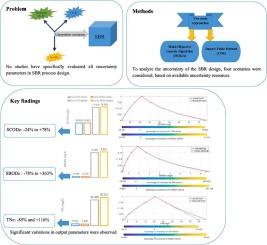Uncertainty analysis of the Sequencing Batch Reactor process using the Fuzzy Sets Theory
IF 6.3
2区 工程技术
Q1 ENGINEERING, CHEMICAL
引用次数: 0
Abstract
This study uses Fuzzy Sets Theory to investigate the uncertainty analysis of the Sequencing Batch Reactor (SBR) process, focusing on key input parameters and biokinetic coefficients. Wastewater data from Shahid Chamran University of Ahvaz (SCU) were utilized as the case study, and extreme output values were identified using a Many-Objective Genetic Algorithm (MOGA) and the Impact Table Method (ITM). Four scenarios were developed to evaluate uncertainty in SBR design, each representing different sources of uncertainty. In the most comprehensive scenario (Scenario 4), significant variations in output parameters were observed: soluble BOD (SBODe) varied from −78 % to +363 %, soluble COD (SCODe) ranged from −24 % to +78 %, and total nitrogen in the effluent (TNe) fluctuated between −85 % and +116 %. Additionally, the Food-to-Microorganism (F/M) ratio and organic loading (Lorg) exceeded permissible limits, reaching values of 0.12 kg BOD/kg MLVSS·day and 0.34 kg BOD/m3·day, respectively. The results indicate that the MOGA method enhances the accuracy of effluent quality predictions and provides a robust framework for optimizing SBR processes in practical applications.

利用模糊集理论对序批式反应器工艺进行不确定性分析
本研究采用模糊集理论研究序批式反应器(SBR)工艺的不确定性分析,重点关注关键输入参数和生物动力学系数。案例研究采用了阿瓦士沙希德-查姆兰大学(SCU)的废水数据,并使用多目标遗传算法(MOGA)和影响表法(ITM)确定了极端输出值。为评估 SBR 设计中的不确定性,设计了四种情景,每种情景代表不同的不确定性来源。在最全面的方案(方案 4)中,观察到输出参数的显著变化:可溶性生化需氧量 (SBODe) 从 -78 % 到 +363 % 不等,可溶性化学需氧量 (SCODe) 从 -24 % 到 +78 % 不等,出水总氮 (TNe) 在 -85 % 到 +116 % 之间波动。此外,食物与微生物(F/M)比率和有机负荷(Lorg)也超过了允许限值,分别达到 0.12 千克生化需氧量/千克 MLVSS 天和 0.34 千克生化需氧量/立方米天。结果表明,MOGA 方法提高了出水水质预测的准确性,并为在实际应用中优化 SBR 工艺提供了一个稳健的框架。
本文章由计算机程序翻译,如有差异,请以英文原文为准。
求助全文
约1分钟内获得全文
求助全文
来源期刊

Journal of water process engineering
Biochemistry, Genetics and Molecular Biology-Biotechnology
CiteScore
10.70
自引率
8.60%
发文量
846
审稿时长
24 days
期刊介绍:
The Journal of Water Process Engineering aims to publish refereed, high-quality research papers with significant novelty and impact in all areas of the engineering of water and wastewater processing . Papers on advanced and novel treatment processes and technologies are particularly welcome. The Journal considers papers in areas such as nanotechnology and biotechnology applications in water, novel oxidation and separation processes, membrane processes (except those for desalination) , catalytic processes for the removal of water contaminants, sustainable processes, water reuse and recycling, water use and wastewater minimization, integrated/hybrid technology, process modeling of water treatment and novel treatment processes. Submissions on the subject of adsorbents, including standard measurements of adsorption kinetics and equilibrium will only be considered if there is a genuine case for novelty and contribution, for example highly novel, sustainable adsorbents and their use: papers on activated carbon-type materials derived from natural matter, or surfactant-modified clays and related minerals, would not fulfil this criterion. The Journal particularly welcomes contributions involving environmentally, economically and socially sustainable technology for water treatment, including those which are energy-efficient, with minimal or no chemical consumption, and capable of water recycling and reuse that minimizes the direct disposal of wastewater to the aquatic environment. Papers that describe novel ideas for solving issues related to water quality and availability are also welcome, as are those that show the transfer of techniques from other disciplines. The Journal will consider papers dealing with processes for various water matrices including drinking water (except desalination), domestic, urban and industrial wastewaters, in addition to their residues. It is expected that the journal will be of particular relevance to chemical and process engineers working in the field. The Journal welcomes Full Text papers, Short Communications, State-of-the-Art Reviews and Letters to Editors and Case Studies
 求助内容:
求助内容: 应助结果提醒方式:
应助结果提醒方式:


